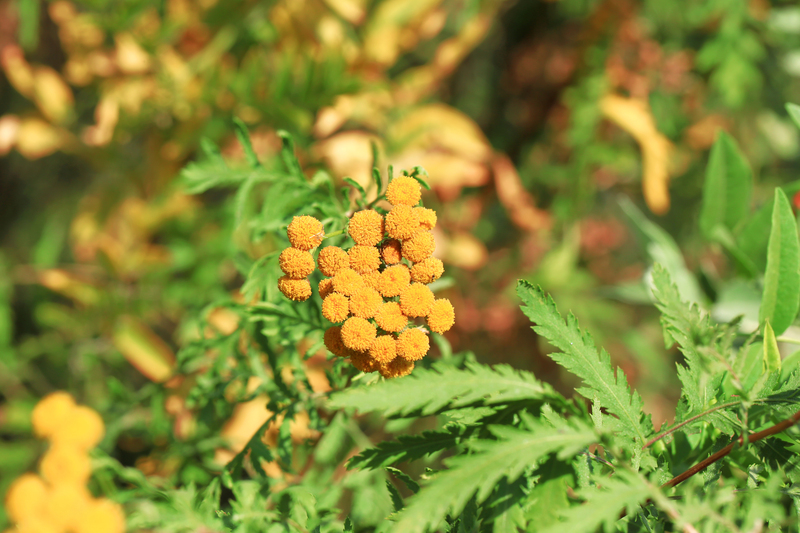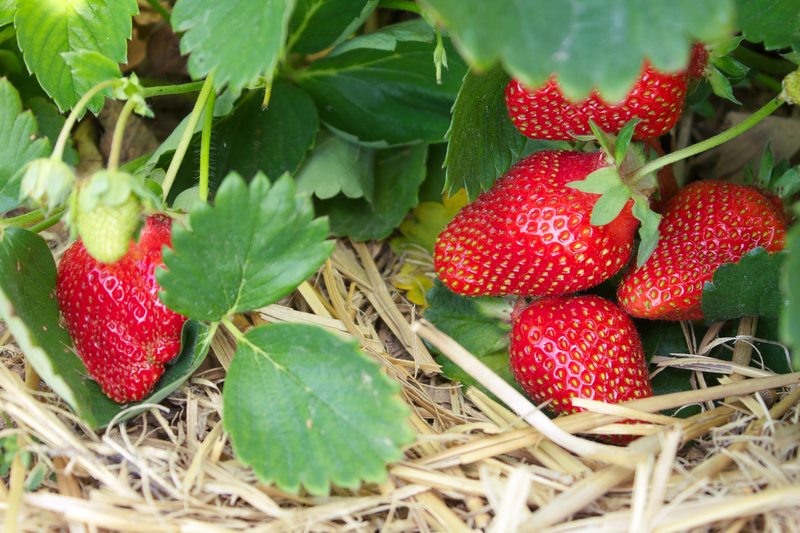Landscaping ideas for harmony between dogs and flowers
Posted on 30/08/2025
Landscaping Ideas for Harmony Between Dogs and Flowers
Creating a beautiful garden oasis that entertains both your four-legged friends and your love for blooming flowers can seem like a tough balancing act. However, landscaping ideas for harmony between dogs and flowers are more achievable than you might imagine. With a bit of planning and the right approach, you can design an outdoor space where dog-friendly landscaping and stunning floral displays coexist beautifully.

Why Merge Dog-Friendly Landscaping with Flower Gardens?
Pets are part of the family, and gardens are often their playgrounds. At the same time, having colorful, fragrant blossoms can bring joy and calmness to any space. Merging these interests brings several benefits:
- Encourages exercise and stimulation for dogs.
- Creates a safe pet-friendly landscape free from poisonous plants.
- Enriches your garden with year-round beauty.
- Fosters harmony between pets and plantings, reducing garden damage.
Let's dive into the most effective landscaping ideas to achieve this balance between dogs and flowers!
Understanding the Challenges: Dogs and Flower Gardens
Before you get started, it's important to recognize the typical challenges dog owners face when trying to create a harmonious garden. Dogs may:
- Dig flower beds or lawns.
- Trample delicate blooms while running or playing.
- Chew or eat plants that may be toxic.
- Mark territory on garden plants.
- Shade or disrupt flower beds by napping in soft soil.
By being aware of these issues, you can plan your dog and flower-friendly garden layout to minimize conflicts and maximize beauty.
Choosing the Right Flowers for a Dog-Friendly Garden
The foundation for harmony between dogs and flowers is careful plant selection. Some flowers and plants can be toxic to pets if ingested, while others can handle a little roughhousing. Here are top tips for choosing appropriate blooms:
Dog-Safe Flowers and Plants
- Sunflowers - Hardy and non-toxic.
- Roses - Beautiful and generally safe (avoid pesticides and beware of thorns).
- Snapdragons - Colorful and safe for pets.
- Marigolds - Easy-to-grow, non-toxic, and can help deter some pests.
- Zinnias - Sturdy, vibrant pet-friendly blooms.
- Bee Balm - Safe and attractive to pollinators.
- Asters - Cheerful color and pet-safe.
- Petunias - Versatile, easy, and safe for dogs.
Avoid these flowers in dog-heavy areas: Lilies, tulips, daffodils, foxglove, oleander, and sago palm, as these are toxic if chewed or eaten.
Tips for Healthy, Resilient Plantings
- Choose robust varieties that recover quickly from minor trampling or play, such as lavender, catmint, and coneflowers.
- Use dense, groundcover plants like creeping thyme or Irish moss to reduce open soil for digging.
- Group delicate plants together in raised beds or containers for added protection.
Designing a Dog and Flower-Friendly Garden Layout
Layout is key for coexistence. By thoughtfully organizing your garden, you can establish clear zones that satisfy both furry friends and botanically-inclined humans.
1. Create Defined Pathways and Play Zones
- Install dedicated dog paths using mulch, gravel, or flagstone. Dogs love to patrol a favorite route – giving them a defined trail reduces random trampling of flower beds.
- Designate a dog play area with grass or durable groundcover to encourage running and fetch without damaging flowers.
2. Use Fencing and Barriers Strategically
- Low decorative fences or sturdy edging can separate flower beds from high-traffic dog areas.
- Consider raised planters and elevated containers to place vulnerable plants out of reach.
- Natural barriers like boxwood hedges or rocks can guide dogs away without blocking views.
3. Plant in Layers for Protection
- Tall plants or shrubs at the back of beds create a natural screen for delicate blooms in the center.
- Layering also adds depth and interest to your garden design while providing resilience against accidental stomping.
4. Choose Durable Groundcovers
- Hard-wearing groundcovers like clover, blue star creeper, or lawn chamomile tolerate heavy use and minimize muddy paws.
Hardscaping Solutions for Landscapes with Dogs and Flowers
Integrate smart hardscape elements that combine function and aesthetics, such as:
- Mulched paths that are gentle on paws and protect soil structure.
- Sturdy patios or decks for people and pets to relax together.
- Water features designed with gentle slopes (for dog safety) and aquatic plants for year-round color.
- Stone or brick edging to create boundaries between dog zones and flower beds.
Dog-Smart Garden Maintenance Tips
Proper upkeep ensures your landscaping ideas for harmony between dogs and flowers remain successful:
- Clean up pet waste regularly to prevent burning and staining on grass and plants.
- Reinforce mulch or gravel paths where wear appears from frequent canine use.
- Use drip irrigation or soaker hoses to target watering and avoid creating muddy patches that might tempt dogs to dig.
- Prune shrubs to keep them dense and discourage wandering paws.
Training and Enrichment: Key for Happy, Well-Behaved Dogs
Training is just as important as design in any successful dog-friendly garden. Use these strategies to help your dog respect boundaries and enjoy the green space safely:
- Teach basic commands like "leave it," "stay," and "off" to redirect attention away from flowers.
- Provide plenty of toys and dig-friendly areas such as a sandpit, so your dog can indulge in natural behaviors without targeting your blooms.
- Reward your dog for using designated paths and staying out of restricted beds.
- Supervise early garden time until habits become set. Consistency is vital.
Creative Landscaping Features for Dogs and Flower Gardens
- Dog-friendly water stations: A small, shallow water feature or a decorative drinking fountain provides refreshment and reduces the urge for dogs to dig in plant beds looking for water.
- Tunnel or agility features: Use colorful tunnels, stepping stones, or weave poles along defined paths for dog exercise and mental stimulation.
- Sun and shade zones: Dogs thrive when they have options; provide both sunny spots and shady retreats using small trees, pergolas, or vine-covered trellises surrounded by sturdy, dog-safe flowers.
- Viewing mounds: Many dogs love a perch to survey their territory. Create a low, well-compacted mound planted with tough grasses or groundcover, ringed by decorative, non-toxic flowers.
Addressing Common Problems in Dog-Flower Harmony Gardens
How to Prevent Digging
- Barrier mulch: Use chunky bark mulch, pea gravel, or large river rocks in flower beds to make them less appealing to dig in.
- Designate an approved digging pit: Fill a corner sandbox or dirt patch with toys and treats, encouraging digging in a safe zone, away from flowers.
- Add wire mesh: Bury chicken wire or hardware cloth just beneath the soil surface in beds prone to digging.
Managing Urine Damage
- Train dogs to use a designated potty area filled with gravel or artificial turf.
- Water the area well after urination to dilute effects and protect nearby plants.
- Grow robust cover crops like clover, which are more urine-resistant, in high-use areas.
Keeping Dogs Out of Restricted Areas
- Use scented deterrents, such as citrus peels, or commercial pet-repellent granules--but ensure they are safe for both pets and plants.
- Place motion-activated sprinklers to gently discourage entry to certain flower beds.
- Reinforce boundaries with low fencing or dense plantings like rosemary or boxwood.
Seasonal Considerations for Dog and Flower Harmony
- Spring: Re-mulch beds; replant hardy dog-safe annuals; check for toxic mushrooms emerging after rain.
- Summer: Provide extra water and shade; monitor for heat stress in both plants and pets.
- Autumn: Rake leaves and check for chewed sticks or dropped nuts that may be hazardous for dogs.
- Winter: Protect delicate perennials with raised beds or coverings; offer dry pathways using stone or gravel; avoid salt-based de-icers near pet paths.
Eco-Friendly Practices That Benefit Both Dogs and Flowers
- Avoid chemical pesticides and fertilizers that can harm pets. Seek out organic gardening solutions.
- Encourage biodiversity by planting native species and maintaining pollinator-friendly zones.
- Set up a compost bin (fenced off from dogs), creating sustenance for flowers without risking pet health.

Frequently Asked Questions about Dog-Friendly Flower Gardens
- Q: What flowers look beautiful and are safe for dogs?
A: Sunflowers, roses, snapdragons, marigolds, zinnias, bee balm, asters, and petunias are both gorgeous and pet-friendly. - Q: How do I keep my dog from trampling my flower beds?
A: Install pathways, use low fencing, and train your dog with positive reinforcement to stay on their routes. - Q: What groundcover works best in dog zones?
A: Clover, creeping thyme, and blue star creeper are durable, low-growing, and non-toxic, making them ideal for high-traffic pet areas.
Conclusion: Achieving Lasting Harmony Between Dogs and Flowers
With planning, training, and smart landscaping ideas, your garden can be a place where dogs and flowers thrive together. By choosing dog-safe blooms, designing zones and paths for canine fun, and using creative protective measures, every member of your household--whether two-legged or four--can enjoy the pleasures of your outdoor space. Start with a few of these tips, experiment with what works for your pup and plants, and soon you'll have a garden that's as harmonious as it is stunning.
Transform your backyard into a paradise where tails wag and flowers bloom--in perfect harmony!



